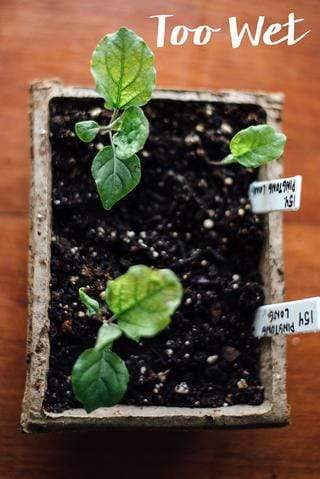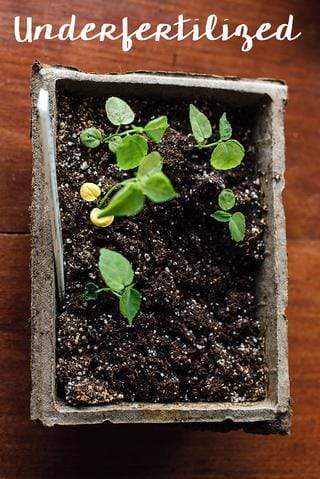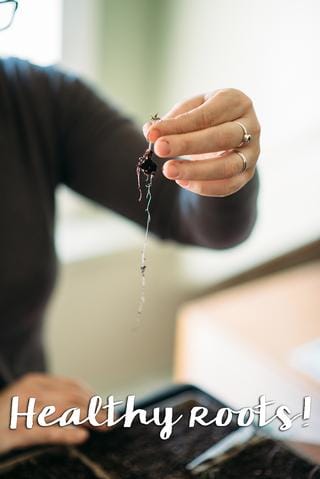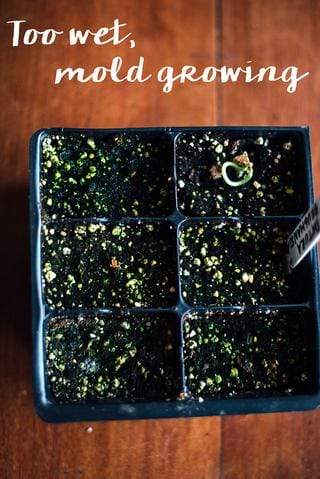Common reasons your seedlings might be failing to thrive
It’s an unavoidable fact that gardening will present you with both wins and losses - hopefully more of the former. But losses are good, they make it easier to see what IS working. Gardening fumbles and failures can be caused by a number of things; some are outside of our control: like a cat digging up your seedlings, or a tray of tiny green shoots sliding off a table after an overzealous hip bump - ask us how we know.
But there are some things you CAN control, many of which require a goldilocks touch: just enough water - not too little, not too much, or just enough light - not too dark, and not too bright.
Here are some of the most common mistakes we found growing from seed - even we make them from time to time so there’s no need to feel bad, it’s all about trowel and error.
1. Seeds fail to germinate

Possible Causes
-
Temperature of the soil is too hot or too cold. Most seeds like a soil temperature of around 65°-75°F. In general,
the warmer the temperature, the faster the seed will germinate.
Please note that even if the air feels warm, the soil may still be chilly. We often recommend a bottom heat source.
- Seeds rotting in the soil means it was too wet. Remember: moist, not soaked!
- Your planting depth - plant too deeply, and germinating seeds have a hard time reaching the surface or light is unable to reach the seed. Most seed packets will instruct you on how deep to plant your seed!
- The growing medium dried out. Your soil should remain moistened but not drenched, and not bone dry.
- ‘Damping off’ disease can affect the seeds before they germinate. Damping off occurs when a pathogen that thrives on too-wet conditions is able to grow and kill the seeds before they can emerge.
2. Seedlings fall over or start to decay at soil level

This is a sign of damping-off disease (fungus organisms that attack seeds and young seedlings, ultimately killing them).
Causes of damping-off:
- Cold, wet soil
- Poor soil drainage
- Poor air circulation
- Unsterilized soil mix, or reusing soil from previous seed starting
- Dirty growing containers
- Stress from low light
3. Leaves start to curl under, growth appears stunted or dwarfed

Possible Causes
-
Too much light. Seedlings need a ‘rest’ period (we can relate!) - it is suggested to only provide 14-16 hours of light.
- Over or under fertilization. Too little nutrients can stunt growth, too much nutrition can damage the roots and prevent the seedling from taking in water.
- Low temperatures. Most seedlings like a soil temperature of around 65°-75° with the air temperatures around 65°-80°.
- Excessive moisture and overwatering. If the soil remains consistently wet, it can rot the roots and prevent the seed from taking in water. It may look like your seed needs water, but in actuality, it needs anything but! Make sure to test the moisture of your soil by feeling with your fingers. Soil should be moist but not soaked. Let the soil dry out a little between waterings.
4. Seedlings have pale, discolored leaves; or leggy, spindly growth

Possible Causes
- Insufficient lighting, or light source too far from your seedlings
- Fertilizer burn from adding too much fertilizer, which can damage the plant's root system
- Excessive watering
- Nutrient deficiency – check the growing medium you are using to find out if nutrients are supplied in the mix. Some have tiny amounts to just get seedlings going, which means you then have to supply the rest until planted out in the garden.
- Overcrowding of seedlings. Be sure to thin your seedlings to prevent this.
- Temperatures too high. Most seedlings like a soil temperature of around 65°-75°.
5. When transplanting, you see poorly developed root systems

Possible Causes
- Poor drainage
- Low soil fertility
- Damage from fertilizer salts, also known as ‘fertilizer burn’ adding too much fertilizer
- Low soil temperatures. Most seedlings like a soil temperature of around 65°-75°.
- Compacted soil (lack of air space in growing medium), which can arise from overwatering and poor drainage.
6. Moss or mold is growing on your medium

Possible Causes
- Lack of air circulation. Set a fan up to move air around your plants
- Excessive moisture. If the soil remains consistently wet, it can rot the roots and prevent the seed from taking in water. It may look like your seed needs water, but in actuality, it needs anything but! Make sure to test the moisture of your soil by feeling with your fingers. Moist, not soaked!
7. Try playing some tunes for your seedlings!
Fact or fiction, we still aren't sure, but rumor has it plants respond well to music! Either way, it sure will lift the gardener's spirits! Why not check out Pinetree's certified Spotify playlist to help your seedlings grow?
A word of encouragement from our Master Gardener and the Head of R&D, Jaci:
“As a gardener, I know how discouraging it can be when some seedlings fail or don’t look perfect. Try not to dwell on it too long; just take the opportunity to gain some knowledge on the possible underlying causes so you can be successful in the seasons ahead. I have been gardening for nearly 20 years, and each year still brings new learning experiences for me,”
To learn more about Jaci, read her interview HERE
Some quick tips for making sure your seedlings flourish!
- Using a soilless seed starting mix to start seeds is very important. Soilless seed starting mix is light, fluffy, and perfect for your seedlings to grow strong, sturdy roots! Garden soil or potting soil is often far too heavy and lacking in drainage, making it hard on the delicate root systems of the young seedlings.
- Once your seedlings have 2-3 sets of leaves, the most important thing to do at this point is to supplement them with nutrients! We recommend using a compost-based seed starting mix like Fort Vee or Fort Light.
- If you're using a seed starting mix without added nutrition, we suggest using ¼ to ½ strength liquid fish or kelp fertilizer every other watering for your seedlings to be at their happiest!



This was helpful in that I believe I need to fertilize, going by the suggestions. I see the person writing this has been gardening for 20 years. That’s commendable! I have been gardening for 45 years—-still learning! I used to be able to start my seeds in my growing medium and not worry, not any more. The new mediums out there just don’t have the nutrients my old one did. At least that’s how it seems to me. Thanks for the article. It was helpful.
At first sign of damping off, water from top with chamomile even if they don’t need water, drain well and do not rewater til soil is on the dry side. Has worked for me to save most of the damping off seedlings!
I start all my seeds in pure compost from my piles, screened through 1/4” hardware cloth, with a sprinkle of bone meal mixed in. If snow melt here in Vermont is late and even raised beds are too wet to work, they get weekly fish emulsion to keep them vigorously growing, or even potting up for those that like warm soil. So I take care not to start seed too early since younger vigorous transplants do better than older root-bound ones.
No need to buy that expensive sterile nutrient-less starting mix that dries out so fast if you have compost that stays so nicely moist and is forgiving if neglected for a day or three. I bring in several 5 gallon buckets full each fall and store in cool cellar with an old dinner plate on top so it has a bit of air around the edges and stays damp but not moldy. The worms (and no doubt the beneficial bacteria and fungi) are still living when I start my seeds in spring. I put the worms in kitchen compost and dump them into the outdoor pile.
Only had damping off 2 years out of almost 30 here, and the chamomile tea did the trick for most of the seedlings.
Potting soil also causes little flying bugs similar to fruit flys
Excited about gardening this year!
The only time you water from the top is when you water the seeds in initially. From then on, whether seeds have sprouted or not, water from the bottom to draw the roots down and create strong root systems It’s time to water when you lift a pot or six-pack and the tray beneath it is no longer damp. Add only enough water to fill the tray about 1/4 inch.